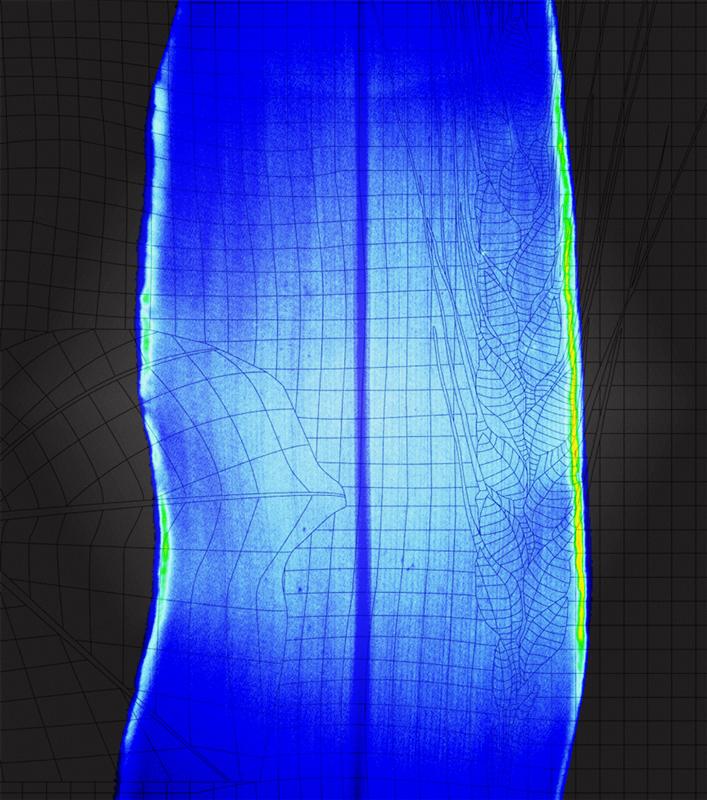CSIRO High Resolution Plant Phenomics Centre 2010
Plants under the microscope artist in residence - October to November 2010




As the recipient of the 2010 Plants Under the Microscope Artist-in-Residence at the High Resolution Plant Phenomics Centre (HRPPC) on Black Mountain in Canberra, I was commissioned to create a installation for permanent display in the main foyer of the facility. For this residency I created the new work, Radiance, 2010, a series of 4 panels (80h x 70w) using fluorcam and hand drawing, screenprint and digital imaging on perspex.
For two months I had an amazing opportunity to look at how the Centre’s scientists are perceiving plant growth through new generation computer visualisation and robotic technologies. I joined the team including Scientific Director Dr Bob Furbank, Alyssa Weirman, Dr Xavier Sirault, Dr David Deerman, Scott Berry, Scott Kwasny, Xueqin Wang and Richard Poiré.
Opened in September 2009 the Centre is newly housed in a fabulous retro-fitted space-aged designed building with round edge porthole windows. A bit like stepping into a 1960s television set from Get Smart, inside it is all smooth lines, glass panels, white walls and sliding doors. As a certified PC2 facility I had to follow guidelines about security so that GM and non-GM crops aren’t trailed in and out. One waits for automatic doors to close while another one opens, it is all clean and white with uncluttered spaces.
The HRPPC focuses on ‘deep phenotyping’ which means thoroughly investigating and understanding a plant’s metabolism and physiological process within. They also set out to determine the plants mechanistic behaviour through ‘reverse phenomics’. A plant’s phenotype is any observable characteristic or traits it displays which is the combination of both its genetic expression and the influence of environmental factors. To work out how to grow crops in a changing environment the HRPPC, is developing and employing advanced research tools to survey the function and performance of crop species under controlled conditions in the laboratories and out in the field. The HRPPC uses a combination of technologies and apply them through range of robotics, imaging and computing. It probes a whole range of conditions such as drought and salinity tolerance, heat and frost etc. The investigation focuses on both individual plants and large scale ecosystems. For example they have commissioned a remote control blimp that can hover above while recording information across an entire field.
I learnt how to use the following equipment; The infrared Camera, a FLIR SC660, which is a high performance infrared system used for science and research applications within the long wave spectral range; and the closed and open sytem FluorCams, which image the multispectral kinetic fluorescence of plants.
Erica Seccombe, Radiance, Plants Under the Microscope Artist-in-Residence | The High Resolution Plant Phenomics Centre CSIRO Black Mountain, ACT.
Utilising these two technologies I constructed an image based installation of six panels for their new teacher resource gallery in the main foyer of the building. I wanted to create work that emphasised the Centre’s brief to understand the whole plant, including its environment. I also chose to use Perspex panels for the installation, rather than printing on paper, to extend the sensation when being in the laboratory, of glass windows and reflection from one room to the next. For the first four panels I narrowed down four images from the Fluorcam which were inkjet printed on one side of the Perspex. To emulate the 3D robotic technology the Centre will be employing to map the external plant growth, I selected several agricultural crop plants and drew the external mesh and hand screenprinted this in iridescent ink on the reverse side. Choosing four FLIR images, I inkjet printed them on both sides of two panel. By overlaying images on the Perspex, the work becomes transparent and transforms as the viewer walks past.
This installation, entitled Radiance, was opened on the 30 November and is now on permanent display in the foyer of the High Resolution Plant Phenomics Centre.
- Injet printing: ANU Inkjet Research Facility, Photography and Media Arts, ACT.
- screenprinting: Megalo Print Studio + Gallery, Watson, ACT.
Published 12 March 2013 in Karl Haro von Mogel, 'Taking the Phenonmics Revolution into the field,' CSA, Crops, Soils, Agronomy, Online Magazine
